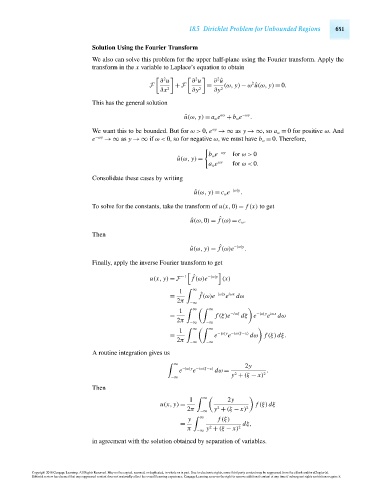Page 671 - Advanced_Engineering_Mathematics o'neil
P. 671
18.5 Dirichlet Problem for Unbounded Regions 651
Solution Using the Fourier Transform
We also can solve this problem for the upper half-plane using the Fourier transform. Apply the
transform in the x variable to Laplace’s equation to obtain
2 2 2
∂ u ∂ u ∂ ˆu 2
F + F = (ω, y) − ω ˆu(ω, y) = 0.
∂x 2 ∂y 2 ∂y 2
This has the general solution
ωy
ˆ u(ω, y) = a ω e + b ω e −ωy .
ωy
We want this to be bounded. But for ω> 0, e →∞ as y →∞,so a ω = 0 for positive ω.And
e −ωy →∞ as y →∞ if ω< 0, so for negative ω,wemusthave b ω = 0. Therefore,
b ω e −ωy for ω> 0
ˆ u(ω, y) =
a ω e ωy for ω< 0.
Consolidate these cases by writing
ˆ u(ω, y) = c ω e −|ω|y .
To solve for the constants, take the transform of u(x,0) = f (x) to get
ˆ
ˆ u(ω,0) = f (ω) = c ω .
Then
ˆ
ˆ u(ω, y) = f (ω)e −|ω|y .
Finally, apply the inverse Fourier transform to get
−1 ˆ −|ω|y
u(x, y) = F f (ω)e (x)
1 ∞ −|ω|y iωx
ˆ
= f (ω)e e dω
2π −∞
1 ∞ ∞
e
= f (ξ)e −iωξ dξ e −|ω|y iωx dω
2π
−∞ −∞
1 ∞ ∞
e
= e −|ω|y −iω(ξ−x) dω f (ξ)dξ.
2π
−∞ −∞
A routine integration gives us
∞ 2y
e
e −|ω|y −iω(ξ−x) dω = .
y + (ξ − x) 2
2
−∞
Then
1 ∞ 2y
u(x, y) = f (ξ)dξ
2
2π y + (ξ − x) 2
−∞
y ∞ f (ξ)
= dξ,
π −∞ y + (ξ − x) 2
2
in agreement with the solution obtained by separation of variables.
Copyright 2010 Cengage Learning. All Rights Reserved. May not be copied, scanned, or duplicated, in whole or in part. Due to electronic rights, some third party content may be suppressed from the eBook and/or eChapter(s).
Editorial review has deemed that any suppressed content does not materially affect the overall learning experience. Cengage Learning reserves the right to remove additional content at any time if subsequent rights restrictions require it.
October 14, 2010 15:27 THM/NEIL Page-651 27410_18_ch18_p641-666

